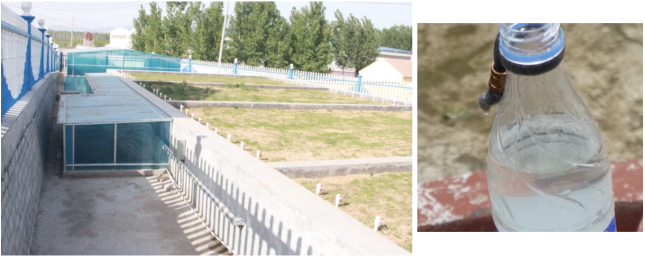-
Not Too Big—Not Too Small—Just Right: Sand Bioreactor Wastewater Treatment in Chinese Villages
May 9, 2019 By Karen Mancl
One year after the Sichuan earthquake, while visiting villages near Wenchuan, I asked local officials planning reconstruction about their plans for wastewater treatment. As an agricultural engineering professor, I was not surprised to learn that they had no plans. It was not that a wastewater treatment system was too expensive, they worried that it would be too big.
Because it is illegal to convert high-quality cultivated land to non-agricultural use, even in new villages surrounded by open fields, that unused land may not be used to construct large wastewater treatment systems. The treatment system must be built inside the village. Lacking space, the impressive new buildings I saw in a new village (photo on left above) let their untreated wastewater flow into a stream (photo on right above).
China’s 2.8 million villages discharge 21 to 24 million tons of wastewater each day, about as much wastewater discharged daily in the United States. Before 2012, virtually no wastewater treatment was available in rural China. By 2016, only 22 percent of villages had wastewater treatment systems, compared to 93 percent in cities. Today, 50 percent of China’s untreated wastewater comes from rural areas, further degrading already polluted waterways and threatening human health. China’s countryside is in urgent need of accessible solutions for clean water.
Right for the City—Wrong for the Village
Large cities around the world treat hundreds of thousands of cubic meters of sewage each day in mechanical treatment plants. These plants use a lot of electricity and require highly-trained staff working around the clock. Wastewater treatment technology companies can shrink the big city technology down to a size to serve less than 1,000 people. But without the steady flow of wastewater and the attention of trained operators, the village-sized mechanical treatment plants fell far short of pollution control standards.
As a result, the early efforts that provided funding for the construction of mechanical wastewater treatment plants in rural China were not effective. Since plant operation and maintenance were left to the local government and because electrical and labor costs were high, the new plants were ignored and soon failed.
Chinese rural governments have built wastewater stabilization ponds and constructed wetlands as an alternative system to serve villages. These natural systems do not need electricity or constant attention and cost only 0.1 RMB to treat a cubic meter of wastewater, one-tenth the cost of a mechanical treatment plant. However, ponds and wetlands require large, flat areas, which are in short supply in China. Large open sewage treatment ponds or wetlands eat up the land a village could use for playgrounds, gardens, or athletic fields.
Just Right for a Village
A promising solution to China’s rural wastewater-land shortage conundrum was used in the late 1800s in more than two dozen Massachusetts villages. Villages built a special type of wastewater treatment system, called a sand bioreactor, with local sand. Wastewater sprayed in small doses on the sand throughout the day filtered down through. Naturally occurring microbes started growing on the sand grains, consuming and removing the wastewater pollutants. These simple systems operated for decades, through hot summers and harsh winters, trouble-free.
As technology advanced, engineers forgot about sand bioreactors and focused on mechanical treatment plants. It was not until the 1980s that these plants were “rediscovered” by U.S. engineers seeking low-energy treatment systems that produce extremely clean effluent in the wake of new environmental regulations and the energy crisis. For example, six sand bioreactor systems were built in upstate New York towns to protect fragile trout streams.
Sand bioreactors are a medium-size treatment system. They are smaller than stabilization ponds and constructed wetlands but larger than mechanical treatment plants. A sand bioreactor is less than 20 percent the cost to construct and operate at the same capacity mechanical plant. It is simpler to operate and uses very little electricity. Finally, and most importantly for Chinese villages, they are buried. The area above the sand can be used as the community park or playground that are a part of all new villages. Sand bioreactors also generate no sludge, which is a major burden for cities operating mechanical treatment systems.

Treatment Systems for Chinese Villages
Transferring technology from one country to another can be tricky. For example, water use and construction practices may vary. Collaborating with local experts is essential to the design and construction process. Starting in 2009, I led the Ohio State University (OSU) research team that worked with the Shandong Academy of Agricultural Sciences (SAAS) to develop a sand bioreactor system for Chinese villages.
The first demonstration sand bioreactor was constructed on Weishan Island in southern Shandong Province. The system was for 1,200 people and cost 200 RMB ($30) per person to construct. The soccer field-sized (680 m2) system is buried and planted with grass.

In Lejia Village, in western Shandong Province, an OSU/SAAS sand bioreactor was constructed in 2015 as a part of a new park. The system serves 360 residents and cost 270,000 RMB ($40,000). Its clean, clear effluent is discharged to a nearby stream.

It Can Be Easy Being Green
Sand bioreactors are easy to build and operate. Clean, uniform sand, local construction materials, and equipment are used to build the treatment plants. The operator cares for the small pumps that spray the wastewater several times each day onto the sand bed. To help encourage replication and make these systems easy to design, OSU’s Department of Food, Agricultural and Biological Engineering has published design manuals in both English and in Chinese.
Researchers at OSU have even modified the design to work for wastewater from restaurants and food processing plants. A full-size (757 m3/day) sand bioreactor plant has been operating in the United States at a slaughterhouse near Cincinnati since 2012 with no water pollution violations for its discharge into a recreational stream. The slaughterhouse saved $10 million over the cost of a mechanical treatment system by building its own sand bioreactor system. This technology could help to reduce pollution and eliminate sludge production from China’s more than 35,000 food processing plants.

Rural Vitalization
The Chinese government’s ongoing efforts to revitalize and modernize rural China have helped raise access to piped drinking water in agricultural areas to over 69 percent by 2018. As public water systems are brought to Chinese villages, the volume of wastewater will steadily increase. By 2035, Xi Jinping’s administration aims to create equal access in both cities and villages to basic public services, particularly wastewater treatment. However, investing in rural wastewater treatment requires a different approach since technologies that work well in the city struggle to perform in small villages. Qingfeng Zhang, Director of Environment, Natural Resources and Agriculture, at the Asian Development Bank, cautions that different regions in China will need different solutions to develop rural wastewater technologies. By looking back to older, simpler treatment technologies, new, low-cost options can be rediscovered, modernized and brought into the 21st century.
Karen Mancl is a Professor of Food, Agricultural and Biological Engineering at The Ohio State University and Director of the OSU Soil Environment Technology Learning Lab. In 2019, she is working as a research assistant in the Woodrow Wilson China Environment Forum. She holds a Ph.D. in water resources from Iowa State University and an MA in East Asian Studies from Ohio State University.
Sources: American Society of Agricultural and Biological Engineers, Asian Development Bank, Asian Journal of Water, Business Insider, China Daily, Environment and Pollution, Environmental Science and Pollution Research, Frontiers in Ecology and the Environment, Habitat International, Journal of Environmental Monitoring, Ohio State University Extension, Shandong Academy of Agricultural Sciences, Sustainability, The Atlantic, U.S. Environmental Protection Agency, Water and Waste Digest, Xinhuanet.
Photos: All photos courtesy of the author. All rights reserved.
 A Publication of the Stimson Center.
A Publication of the Stimson Center.







